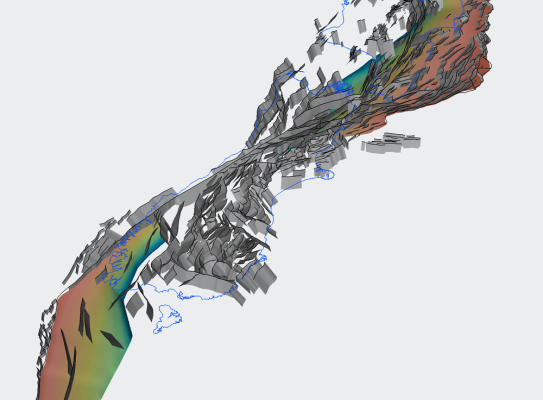
New Zealand Community Fault Model

This project is developing 2D and 3D models of Aotearoa New Zealand’s active fault zones.
Overview
This project is developing 2D and 3D models of Aotearoa New Zealand’s active fault zones.
This programme aims to
- Provide a scientifically agreed upon active fault model for use in seismic hazard assessment, strong ground-motion predictions, and physics-based fault systems modelling
- Provide geometric and kinematic information for active fault zones including those considered, but not proven, to be capable of generating medium to large magnitude earthquakes
- Ensure the model meets FAIR Data Principles by being findable, accessible, interoperable and reusable for everyone
To achieve these aims
- We collaborate with more than 40 Earth scientists and engineers across New Zealand
- We consolidate all available geological and geophysical data on active fault zones into one place
The project
New active fault model a crucial resource
Sitting astride the boundary between the Australian and Pacific tectonic plates, Aotearoa New Zealand is an earthquake-prone nation. Earthquakes generally occur on fault zones that, in most cases, can be mapped at or near the surface. A scientific community-driven two- and three-dimensional model of active fault zones is a foundational resource for applications such as the National Seismic Hazard Model, tsunami hazard assessment, earthquake ground-motion predictions, and other aspects of earth deformation research.
These types of projects all contribute to a better understanding of the risk seismic hazard presents to our communities and infrastructure networks. The more we understand about fault zones that are capable of generating medium to large magnitude earthquakes, the better decisions we as a society can make about the location and engineering of buildings and critical infrastructure. Understanding our faults also helps with civil defence planning and response, and the resilience of our communities to future events.
The New Zealand Community Fault Model, an exercise in collaboration
The New Zealand Community Fault Model is a representation of known active fault zones that run along the length of the New Zealand plate boundary. This multi-agency collaboration led by GNS Science leverages the expertise of more than 40 earth scientists and engineers from across the country. We brought together geologists and geophysicists from many organisations in a series of workshops to draw on this community’s wealth of knowledge. These scientists helped define the model, including its limitations, through engagement and input to ensure it is fit-for-purpose.
Version 1.0
The first edition of the New Zealand Community Fault Model (v1.0) comprises nearly 900 fault zones. The model comprises two principal datasets. The first dataset is a two-dimensional representation of active (or potentially active) fault zone traces. These data contain information on the geometric and kinematic attributes of each fault zone or fault zone segment as expressed on the ground surface. The second dataset is a three-dimensional representation of the fault zones in the model.
As well as active fault zones, the model includes fault zones that fall outside the traditional definition of active – having demonstratable rupture in the last 125,000 years – but are considered capable of generating medium to large magnitude earthquakes or seafloor displacements. Overall, the fault zone location and parameter descriptions have been improved on from previous active fault models.
The New Zealand Community Fault Model (v1.0) is publicly available. The model has been released under a creative commons license which permits sharing and adaptation so long as appropriate credit is given. The data package includes geographic information system projects and files of the two-dimensional fault zone model along with triangulated surfaces for the three-dimensional fault zone model, tabulated fault zone parameters and documentation.
It is envisaged that the New Zealand Community Fault Model (v1.0) will provide the starting point for future updates by the scientific community as new data and knowledge becomes available. It is our expectation that progressively refined and updated versions of the active fault model will be developed, documented and released.
A broad range of uses
The uses of the model are varied. We anticipate that subsequent versions of the model will contain alternative model representations with varying levels of detail dependent on the needs of end users.
Potential research applications include:
- Dynamic earthquake rupture modelling
- Earthquake source modelling
- Ground motion simulation
- Geodetic modelling
- Tsunami modelling
-
Publications
Reference documents
Hannu Seebeck, Russ Van Dissen, Nicola Litchfield, Philip M. Barnes, Andrew Nicol, Robert Langridge, David J. A. Barrell, Pilar Villamor, Susan Ellis, Mark Rattenbury, Stephen Bannister, Matthew Gerstenberger, Francesca Ghisetti, Rupert Sutherland, Hamish Hirschberg, Jeff Fraser, Scott D. Nodder, Mark Stirling, Jade Humphrey, Kyle J. Bland, Andrew Howell, Joshu Mountjoy, Vicki Moon, Timothy Stahl, Francesca Spinardi, Dougal Townsend, Kate Clark, Ian Hamling, Simon Cox, Willem de Lange, Paul Wopereis, Mike Johnston, Regine Morgenstern, Genevieve Coffey, Jennifer D. Eccles, Timothy Little, Bill Fry, Jonathan Griffin, John Townend, Nick Mortimer, Samantha Alcaraz, Cécile Massiot, Julie V. Rowland, James Muirhead, Phaedra Upton & Julie Lee (2023) The New Zealand Community Fault Model – version 1.0: an improved geological foundation for seismic hazard modelling, New Zealand Journal of Geology and Geophysics, DOI: 10.1080/00288306.2023.2181362(external link)
Seebeck H, Van Dissen R, Litchfield N, Barnes P, Nicol A, Langridge R, Barrell DJA, Villamor P, Ellis S, Rattenbury M, Bannister S, Gerstenberger M, Ghisetti F, Sutherland R, Fraser J, Nodder S, Stirling M, Humphrey J, Bland K, Howell A, Mountjoy J, Moon V, Stahl T, Spinardi F, Townsend D, Clark K, Hamling I, Cox S, de Lange W, Wopereis P, Johnston M, Morgenstern R, Coffey G, Eccles JD, Little T, Fry B, Griffin J, Townend J, Mortimer N, Alcaraz S, Massiot C, Rowland J, Muirhead J, Upton P, Hirschberg H, Lee J, 2022, New Zealand Community Fault Model – version 1.0. Lower Hutt (NZ): GNS Science. 96 p. (GNS Science report; 2021/57).
Access to the model, data and related publications are available here:
New Zealand Community Fault Model V 1.0

Research programme details
Collaborators: National Institute of Water and Atmosphere (NIWA), TerraGeoLogica, Victoria University of Wellington, Golder, University of Otago, University of Canterbury, the University of Waikato, BECA, the University of Auckland, Geoscience Australia
Duration
2019–2021
Funding platform
MBIE, Resilience to Nature’s Challenges, Strategic Science Investment Fund
Status
Current
Programme leader
Russ Van Dissen, GNS Science
Funder
Ministry of Business, Innovation & Employment (MBIE), Resilience to Nature’s Challenges, Strategic Science Investment Fund
Find more content related to:
GNS Science topics
- Strategic Science Investment Fund
- Earthquakes
- Infrastructure
- Modelling
- Natural hazards
- Resilience
- Risk